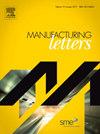淬硬工具钢松散磨料抛光表面粗糙度及残余应力发展的实验研究
IF 2
Q3 ENGINEERING, MANUFACTURING
引用次数: 0
摘要
人工松磨金刚石抛光工件表面完整性的可重复性和可控制性是非常有限的。本文首先利用自动金相磨床对淬硬工具钢X37CrMoV5-1表面粗糙度和近表面残余应力的影响进行了研究。结果表明,抛光参数(如晶粒尺寸、压板速度和施加在工件上的力)对粗糙度和残余应力有不同的影响。残余应力深度剖面的XRD测量表明,压缩应力减小,这可以用材料去除机制和方向来解释。本文章由计算机程序翻译,如有差异,请以英文原文为准。
Experimental study on surface roughness and residual stress development in loose-abrasive polishing of hardened tool steel
The repeatability and control of the achievable surface integrity in manual loose-abrasive diamond polishing of workpieces is very limited. In this study, first effects of polishing on the surface roughness and on induced near-surface residual stress of hardened tool steel X37CrMoV5-1 using an automatic metallographic grinder polisher have been investigated. The results show different effects of polishing parameters such as grain size, platen speed and forces applied to the workpiece on roughness and residual stress. XRD measurements of the residual stress depth profile showed a reduction in compressive stress which could be explained by the material removal mechanism and direction.
求助全文
通过发布文献求助,成功后即可免费获取论文全文。
去求助
来源期刊

Manufacturing Letters
Engineering-Industrial and Manufacturing Engineering
CiteScore
4.20
自引率
5.10%
发文量
192
审稿时长
60 days
 求助内容:
求助内容: 应助结果提醒方式:
应助结果提醒方式:


